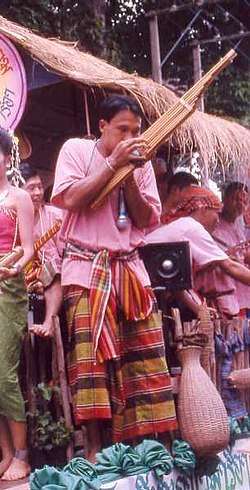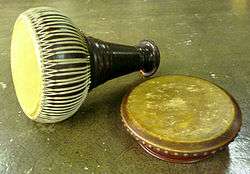Khene
The khene (/ˈkɛn/; spelled "Can" in English; Lao: ແຄນ; Thai: แคน, RTGS: khaen, pronounced [kʰɛ̄ːn]; Vietnamese: khèn) is a mouth organ of Lao origin whose pipes, which are usually made of bamboo, are connected with a small, hollowed-out hardwood reservoir into which air is blown. Today associated with the Lao people of Laos and Isan, other similar instruments date back to the Bronze Age. In Cambodia, it is used among the ethnic Lao population of the province of Stung Treng and is used in lakhon ken, a Cambodian dance drama genre that features the khene as the premiere instrument.[1][2] In Vietnam, this instrument is used among the Tai peoples and the Muong people. The most interesting characteristic of the khene is its free reed, which is made of brass or silver. It is related to Western free-reed instruments such as the harmonium, concertina, accordion, harmonica, and bandoneon, which were developed beginning in the 18th century from the Chinese sheng, a related instrument, a specimen of which had been carried to St. Petersburg, Russia.

The khene has five different lai, or pentatonic modes with specific drone pitches, organized into two families (thang san and thang yao). The thang san family includes lai sutsanaen (G A C D E), lai po sai (C D F G A), and lai soi (D E G A B), while the thang yao family includes lai yai (A C D E G) and lai noi (D F G A C). Lai po sai is considered to be the oldest of the modes and lai sutsanaen the "Father of the Lai Khaen." Khene can be played as a solo instrument (dio khene), as part of an ensemble (such as wong pong lang and khene wong), or as an accompaniment to a Lao or Isan solo singer mor lam.
Composers who have written notated music for the instrument include Annea Lockwood, Christopher Adler, David Loeb, Sidney Marquez Boquiren, Christopher Burns, Jinhee Han, H. James Harkins, Jeff Herriott, Vera Ivanova, and Yu Kuwabara.
Players

In Thailand, one of the top virtuoso khaen soloists is the blind musician Sombat Simla. The instrument has also attracted a few non-Asian performers, including University of San Diego professor Christopher Adler, who also composes for the instrument; English musician Clive Bell (UK); Vancouver-based composer/performer Randy Raine-Reusch (Canada), who played khaen on Aerosmith's Pump (1989), Cranberries' To the Faithful Departed (1996), and Yes's The Ladder (1999); and Jaron Lanier (United States). Since the early 21st century, the California-born khaen player Jonny Olsen has achieved familiarity in Laos and Thailand by appearing on numerous Thai and Lao TV Shows and performing live concerts in Thailand and the U.S. Olsen is the first foreigner to win a khaen championship in Khon Kaen, Thailand in 2005. Stephen Molyneux (United States) has played the khaen on his releases The Arbitrary State (2010), The Stars Are the Light Show (2012), Wings and Circles (2016), and in select live performances. Molyneux bought a khaen in Bangkok in 2010 after developing an interest in the instrument while traveling in Laos and Thailand.
Tuning
It has seven tones per octave, with intervals similar to that of the Western diatonic natural A-minor scale: A, B, C, D, E, F, and G. A khene can be made in a particular key but cannot be tuned after the reed is set and the pipes are cut.
Notes
- <http://www.jiras.se/lakhaon2010/kraythong/info.html>; pictures of performance with the instrument can be seen at <http://www.jiras.se/lakhaon2010/kraythong/index.html>
- Referred to as 'Ken Theatre' or lakhaon ken in <http://unesdoc.unesco.org/images/0013/001352/135258eb.pdf >
Bibliography
- Miller, Terry E. Traditional Music of the Lao: Kaen Playing and Mawlum Singing in Northeast Thailand (1985). Contributions in Intercultural and Comparative Studies, no. 13. Westport, Connecticut: Greenwood Press.
- Miller, Terry E. An Introduction to Playing the Kaen (1980). Kent, Ohio: Terry E. Miller.
- Lilly, Joseph An Introduction to the Khaen of Laos:The Free-Reed Journal Articles and Essays Featuring Classical Free-Reed Instruments and Performers
External links
- Educational Video about Khaen What is the khaen and how it is played
- Khaen Baet and Khaen Hok
- Khaen Repertories: The Developments of Lao Traditional Music in Northeast Thailand Accessed 13 May 2005.
- Audio samples
- Traditional Music and Songs in Laos: The Voice of the Lao Khen
- Art of the States: khaen Three contemporary American works featuring the instrument
- Jaron Lanier using his invented style of playing, extraordinary.
- Khaen Master Nouthong Phimvilayphone playing Lotfai talang on YouTube
